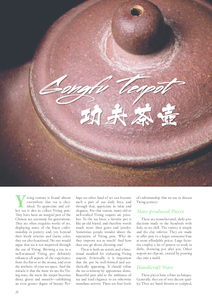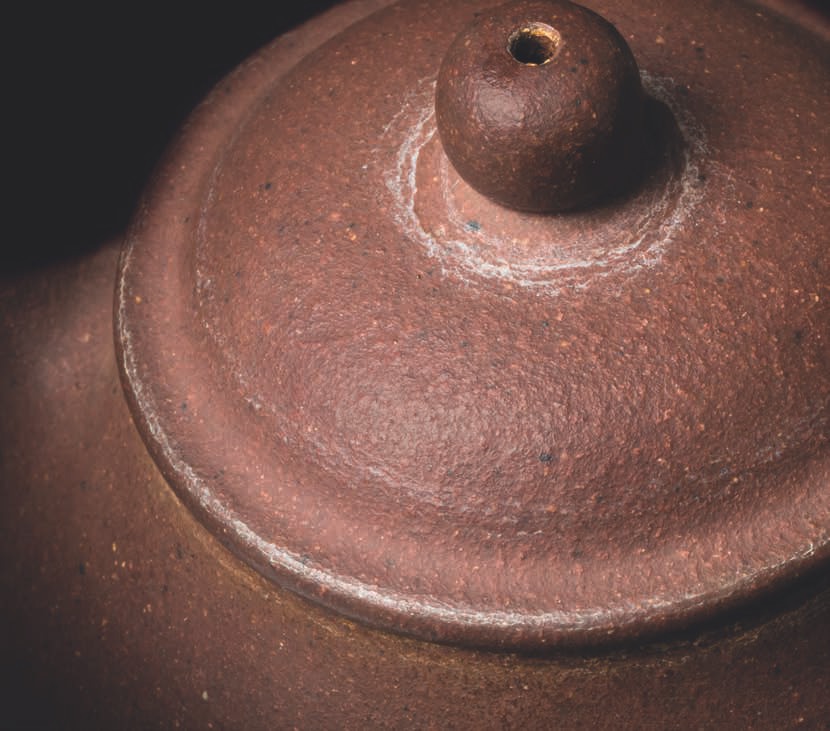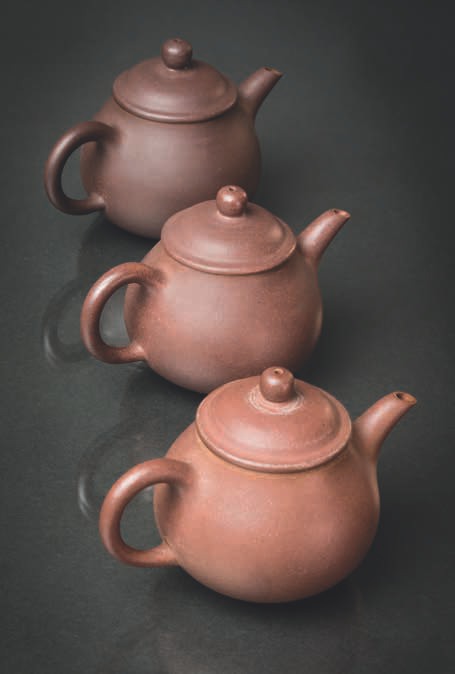
 |
|

Yixing teaware is found almost everywhere that tea is cherished. To appreciate and collect tea is also to collect Yixing pots. They have been an integral part of the Chinese tea ceremony for generations. They are often exquisite works of art, displaying some of the finest craftsmanship in pottery, and, yet, beyond their lovely exterior and classic color, they are also functional. No one would argue that tea is not improved through the use of Yixing. Brewing a tea in a well-seasoned Yixing pot definitely enhances all aspects of the experience, from the flavor to the aroma, and even the aesthetic of your tea space. And the miracle is that the more we use the Yixing ware, the more the teapot becomes shiny, glossy and smooth - exhibiting an even greater degree of beauty. Perhaps no other kind of art can become such a part of our daily lives, and through that, appreciate in value and elegance. For that reason, many old or well-crafted Yixing teapots are priceless. To the tea lover, a favorite pot is like an old friend, and therefore worth much more than gems and jewelry. Sometimes people wonder about the reputation of Yixing pots. Why do they improve tea so much? And how does one go about choosing one?
There is both an artistic and a functional standard for evaluating Yixing teapots. Artistically, it is important that the pot be well-formed and aesthetically appeasing. It should refine the tea ceremony by appearance alone. Beautiful pots add to the ambiance of tea and lend elegance to an otherwise mundane activity. There are four levels of craftsmanship that we use to discuss Yixing pottery:
These are manufactured, daily productions made in the hundreds with little to no skill. The variety is simple and the clay inferior. They are made to offer pots to a larger consumer base at more affordable prices. Large factories employ a lot of potters to work in shifts, throwing pot after pot. Other teapots are slipcast, created by pouring clay into a mold.
These pieces have a finer technique. Generally, they are of very decent quality. They are hand thrown or sculpted, and some time is taken to ensure the quality and limit the amount of each. They also display a greater variety of design and form, though they are often imitations of historic pieces or cultural trends through time.
These pieces are made by celebrity potters. They are often expert craftsmen, and the function as well as beauty of the pot will demonstrate this. This class of teapot is a collector's favorite. The rarer they are, the more they will increase in value through use and time.
Some devoted artists exceed even their contemporaries. They have gone beyond simply making pieces of art to a state of mastery. Many of these pots are worth so much that they aren't even used, but exhibited in homes or museums.
When choosing a teapot, one can try to learn about its provenance. Many collectors start their study of Yixing by learning to recognize some of the chop marks on the bottom of the teapots. The chop will either be the name of the artist, or perhaps the factory itself, in the case of mass-produced or handicraft pieces. Nonetheless, it helps to have a teacher to guide our purchases in the beginning. Most often, anyone can distinguish the mass-produced pieces from the other categories, though the discrepancies between the finer groups are more difficult to discern. Still, even mass-produced pieces aren't necessarily undesirable, depending on one's preference of style and budget. It is important, however, for the consumer to know what it is they are buying. For that reason, it's better to buy from a vendor with a good reputation and more transparent product information. Without any help, it's best to just handle the pot for a while, and use one's senses to assess its artistic quality and function. It should have a fine form and structure, with nice proportions between the spout, handle, lid and bottom. The skill of the craftsmanship should be apparent from sight and touch alone, at least to the degree that one can know whether it is handicraft or a higher grade. Of course, the price and personal perspective will also play a part in the selection. It should be functional, and suit the needs of the user in regards to volume, kind of tea and aesthetic representation.
The second criterion for the appraisal of Yixing, functionality, is really not separate from the artistic standard. Many of the values that make a teapot of high functional quality are also related to its artistic worth. Unless one plans to collect the pot and not use it to actually brew tea, the function and artistic value will both be important. These days, most collectors like to talk about three different aspects of a teapot's faculty: clay, shape and technique. The first of these is the clay. One of the major reasons that Yixing has become so famous is that the clay from Yixing Province has a very unique composition. Most kinds of clay have traces of lead in them, which make them unhealthy for daily use. For that reason, potters fire their pieces a second time, using glaze. The glaze is brushed on like paint and has a similar constitution to glass. It fills the pores of the clay and coats it with a layer of protective, smooth finish that removes the threat of the lead, making the cup, bowl or pot functional. Moreover, the variety of colors, techniques and formulas within the glazes add another level of creativity to the artistic process. The clay from Yixing, however, is naturally lead-free. This rare purity allows the craftsman to skip the glazing process altogether and just fire the teapots once in order to harden them. The clay is then left in its natural, porous state. The plethora of pours then begin to absorb the oils from the tea that is used, improving the taste of later brews more and more as the pot gets more "seasoned." For that reason, tea drinkers use only one pot for each kind of tea that they enjoy, since a green tea would be ruined by a pot that was seasoned with puerh.
A fine teapot inevitably comes from superior clay. There is a vast array of clay within Yixing Province; including red, purple, black, brown, green, blue, etc. And each variety of clay has its own characteristics. Some clays go together with certain kinds of tea better. Much of learning the differences between clays is simply about handling them. Teapots are made to be touched. They enjoy being held, and show their appreciation through a brighter surface. If the clay is refined manually in the traditional fashion, it will be worth more. Much of the differences between the mass-produced pieces and the higher grades is just that, the practical pieces are made from machine-processed ore, often mixed with chemicals that alter the color and decrease the cost of the natural materials. Sadly, since the mines were closed in the late 1990s, genuine purple-sand ore from the Yellow Dragon or Blue-Green Dragon mountains grows rarer and rarer. Nowadays, all of the mass-produced pots are made from material imported from other areas of Jiangsu, or even Anhui.


Lu Yao Chen is one famous clay master who refines clay by hand. He said that when he sees ore of very fine quality, he never hesitates to buy it, no matter the price. "As the ore decreases, the highest quality ore will only increase in value. I think it's important that it be refined by hand, the way it was done by my father's father." It will take a beginner some time to recognize the qualities of clay, but one should be able to recognize the poorer clays by sight and touch alone - and sometimes, but not always, by their price tag. Occasionally, we ding the side of the pot with the lid and listen to the sound. Higher pitched ringing means that the pot will be better suited to tea with a strong aroma, like green teas; and a lower, deeper thud means the pot is good for teas with stronger flavors, like oolong and puerh. Choosing a clay that is suitable for the tea that will be brewed in it, as well as a nicer quality clay, that is, if possible, hand-refined is a good place to start, when determining which pot to employ.
The second aspect of function is the pot's shape. Of course, much of the shape is relevant to the creative movement of the artist and the opinion of the collector. But there are some aspects of shape that are important to function as well. As with the clay, some shapes work better with certain kinds of tea. For example, one may not want to use a pot with a very small opening to brew striped tea like Wuyi Cliff Tea. Otherwise, one would have to crush and break the leaves to get them inside. Ball-shaped oolongs, on the other hand, work better in a rounder pot, which gives them room to open up completely and in unison. Remember that some of the potters who make teapots don't drink much tea themselves, and therefore aren't familiar with all the habits involved. Some teapots look nice and have a nicely shaped appearance, but aren't functional at all. One should make sure that the spout pours properly and fluently, as well as that the handle is comfortable and the pouring motion is easy. If the pot is newer, it may have a built-in strainer, to prevent the spout from clogging. Inserting a metal one is sometimes necessary, but not as desirable. In the end, no aspect of the pot should be awkward to handle or use on a daily basis, unless the pot is meant to be artwork for decoration. The beauty of a teapot finds its ultimate expression in the tea ceremony itself. It should have a suitable capacity relative to the amount of tea desired, be of an appropriate height and shape for convenience and display, and have a tight lid and a spout that pours like a gentle river over rocks. In that way, the essences of its artistic and functional qualities are free to articulate their grandeur. When the shape of the pot is symmetrical, balanced and harmonious, a Chajin feels motivated to pick it up and use it to prepare tea, inspired by the aesthetics and craftsmanship of functional art.
The final factor involved in judging the functionality of an Yixing pot is the technique used to create it. Was it thrown on a wheel or hand built? One can see the rings inside if it was thrown (rare and inferior, when it comes to Yixing teapots), and, with some acumen, begin to recognize the skill of the potter. The spout and handle should be precisely in line, and the lid should fit almost perfectly into the opening. The greater the craftsmanship, the more these aspects will stand out. The design and form are also helpful clues for determining the provenance of the piece. The value of teapots, like other art, is often based on the artist's reputation. However, it is a Chinese tradition for students to copy the work of masters, so one must be cautious when purchasing these expensive masterpieces. Some of the technique, therefore, is purely to increase the appearance of the pot. They are decorated with calligraphy, painting, engraving, decorative nature and many other motifs. One should look for technique and method that is unique and creative while at the same time functional - inspiring in appearance and employment.
In the end, a lot of choosing an Yixing pot boils down to predilection. When choosing a pot, a person needs to find one that they like, since they'll be the one using it day in and day out. One's taste, budget and tea preferences will all play vital roles in shopping for a teapot. The basic guidelines outlined here - like having a lid that fits nicely, a melodious sound when dinged with the lid, a proper spout that pours nicely - all of these are just strategies that are, in the end, secondary to your own feelings. Many collectors, when asked to show their favorite pot, will reach back into their shelf and pull out some small and cheap first purchase that served them well for many years and was like a friend that supported them as they grew in understanding of tea and teaware both.

